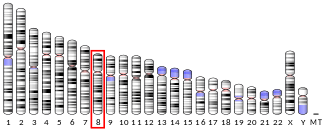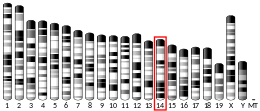FZD3
Frizzled-3 is a protein that in humans is encoded by the FZD3 gene.[5][6][7]
Function
This gene is a member of the frizzled gene family. Members of this family encode seven-transmembrane domain proteins that are receptors for the Wingless type MMTV integration site family of signaling proteins. Most frizzled receptors are coupled to the beta-catenin canonical signaling pathway. It may play a role in mammalian hair follicle development.[7]
The function of this gene is largely derived from mouse studies. Fzd3 in the mouse functions through planar cell polarity signaling instead of the canonical Wnt/beta-catenin pathway. Fzd3 controls axon growth and guidance in the mouse nervous system, and migration of neural crest cells.[8][9]
See also
References
- 1 2 3 GRCh38: Ensembl release 89: ENSG00000104290 - Ensembl, May 2017
- 1 2 3 GRCm38: Ensembl release 89: ENSMUSG00000007989 - Ensembl, May 2017
- ↑ "Human PubMed Reference:".
- ↑ "Mouse PubMed Reference:".
- ↑ Kirikoshi H, Koike J, Sagara N, Saitoh T, Tokuhara M, Tanaka K, Sekihara H, Hirai M, Katoh M (Jun 2000). "Molecular cloning and genomic structure of human frizzled-3 at chromosome 8p21". Biochem Biophys Res Commun. 271 (1): 8–14. doi:10.1006/bbrc.2000.2578. PMID 10777673.
- ↑ Sala CF, Formenti E, Terstappen GC, Caricasole A (Jul 2000). "Identification, gene structure, and expression of human frizzled-3 (FZD3)". Biochem Biophys Res Commun. 273 (1): 27–34. doi:10.1006/bbrc.2000.2882. PMID 10873558.
- 1 2 "Entrez Gene: FZD3 frizzled homolog 3 (Drosophila)".
- ↑ Hua ZL, Smallwood PM, Nathans J (Dec 2013). "Frizzled3 controls axonal development in distinct populations of cranial and spinal motor neurons". eLife. 2: e01482. doi:10.7554/eLife.01482. PMC 3865743. PMID 24347548.
- ↑ Hua ZL, Jeon S, Caterina MJ, Nathans J (Jul 2014). "Frizzled3 is required for the development of multiple axon tracts in the mouse central nervous system". Proc Natl Acad Sci U S A. 111 (29): E3005–14. doi:10.1073/pnas.1406399111. PMC 4115534. PMID 24799694.
Further reading
- Katoh M (2002). "GIPC gene family (Review)". Int. J. Mol. Med. 9 (6): 585–9. doi:10.3892/ijmm.9.6.585. PMID 12011974.
- Finch PW, He X, Kelley MJ, Uren A, Schaudies RP, Popescu NC, Rudikoff S, Aaronson SA, Varmus HE, Rubin JS (1997). "Purification and molecular cloning of a secreted, Frizzled-related antagonist of Wnt action". Proc. Natl. Acad. Sci. U.S.A. 94 (13): 6770–5. doi:10.1073/pnas.94.13.6770. PMC 21233. PMID 9192640.
- Wright M, Aikawa M, Szeto W, Papkoff J (1999). "Identification of a Wnt-responsive signal transduction pathway in primary endothelial cells". Biochem. Biophys. Res. Commun. 263 (2): 384–8. doi:10.1006/bbrc.1999.1344. PMID 10491302.
- Hung BS, Wang XQ, Cam GR, Rothnagel JA (2001). "Characterization of mouse Frizzled-3 expression in hair follicle development and identification of the human homolog in keratinocytes". J. Invest. Dermatol. 116 (6): 940–6. doi:10.1046/j.1523-1747.2001.01336.x. PMID 11407985.
- Katsu T, Ujike H, Nakano T, Tanaka Y, Nomura A, Nakata K, Takaki M, Sakai A, Uchida N, Imamura T, Kuroda S (2004). "The human frizzled-3 (FZD3) gene on chromosome 8p21, a receptor gene for Wnt ligands, is associated with the susceptibility to schizophrenia". Neurosci. Lett. 353 (1): 53–6. doi:10.1016/j.neulet.2003.09.017. PMID 14642436.
- Zhang Y, Yu X, Yuan Y, Ling Y, Ruan Y, Si T, Lu T, Wu S, Gong X, Zhu Z, Yang J, Wang F, Zhang D (2005). "Positive association of the human frizzled 3 (FZD3) gene haplotype with schizophrenia in Chinese Han population". Am. J. Med. Genet. B Neuropsychiatr. Genet. 129 (1): 16–9. doi:10.1002/ajmg.b.30076. PMID 15274031.
- Zhang Z, Henzel WJ (2005). "Signal peptide prediction based on analysis of experimentally verified cleavage sites". Protein Sci. 13 (10): 2819–24. doi:10.1110/ps.04682504. PMC 2286551. PMID 15340161.
- Omoto S, Hayashi T, Kitahara K, Takeuchi T, Ueoka Y (2004). "Autosomal dominant familial exudative vitreoretinopathy in two Japanese families with FZD4 mutations (H69Y and C181R)". Ophthalmic Genet. 25 (2): 81–90. doi:10.1080/13816810490514270. PMID 15370539.
- Hashimoto R, Suzuki T, Iwata N, Yamanouchi Y, Kitajima T, Kosuga A, Tatsumi M, Ozaki N, Kamijima K, Kunugi H (2005). "Association study of the frizzled-3 (FZD3) gene with schizophrenia and mood disorders". Journal of neural transmission (Vienna, Austria : 1996). 112 (2): 303–7. doi:10.1007/s00702-004-0264-2. PMID 15657645.
External links
- "Frizzled Receptors: FZD3". IUPHAR Database of Receptors and Ion Channels. International Union of Basic and Clinical Pharmacology.
This article incorporates text from the United States National Library of Medicine, which is in the public domain.




